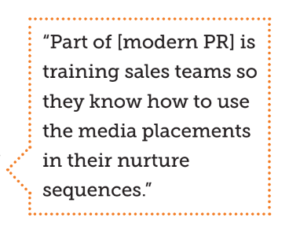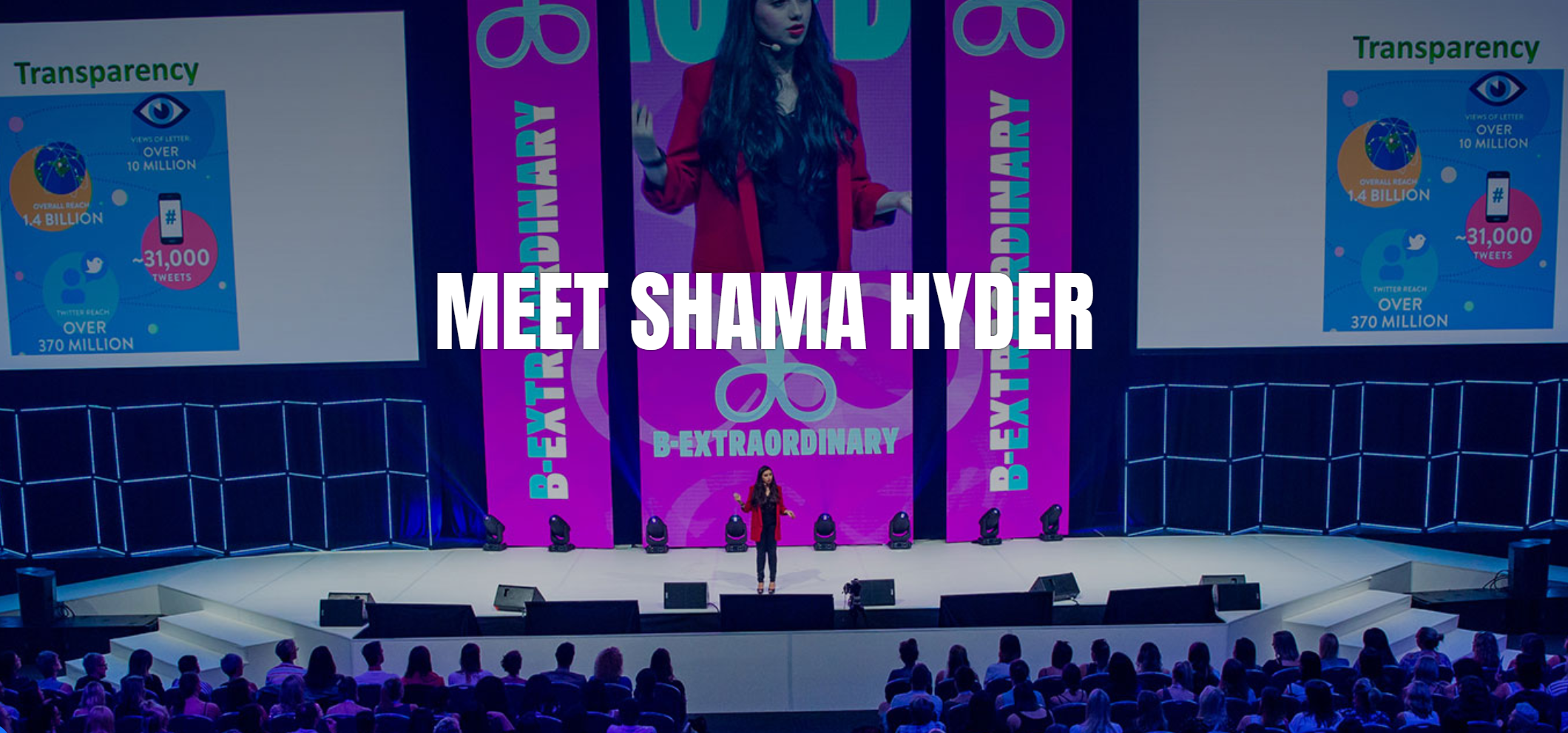“Entrepreneur, CEO, and working-mom Shama Hyder helps B2B and B2C brands make meaningful connections with today’s customer through modern PR. We borrowed some of her precious time to learn about the shifting world of public relations and how it fits into a present-day marketing team.
“The definition of ‘who is the media?’ has evolved tremendously,” says Shama Hyder. “It’s not always a traditional journalist. Today, centers of influence are colliding, and that means taking a more holistic approach to marketing, content, and PR. You have to look beyond a placement or platform to what actually moves the needle for buyers.”
Hyder—a globally respected keynote speaker and author on topics such as selling in the digital age, leadership, and personal branding—is the founder and CEO of Zen Media, which delivers PR and marketing for tech-driven B2B brands. She speaks to audiences and writes often about “PR done for the digital age,” which she describes as PR that goes beyond traditional placement.
“A good way to think about it is ‘PR plus,’” Hyder says. “Traditional media channels have a place, of course, but the traditional media landscape itself is changing.”
Hyder points to the fact that publications with bustling newsrooms are quickly becoming a thing of the past, replaced by freelance journalists wearing multiple hats and writing for multiple publications. Digital PR prioritizes creators who may or may not be traditional full-time journalists. “It starts with understanding a company’s ideal customer profile and their goals,” Hyder says. “Who actually moves the needle for them? Then, get the company in front of that audience, using the platforms and people that are most likely to influence that ideal profile.”
”“The dark-social model looks at how modern buyers buy, which is definitely not in a silo and not trackable. It puts the focus on the meaningful over the merely measurable.”
Hyder believes that while they still have a time and place, traditional press releases are an overused, outdated, and overplayed tactic often implemented to keep out-of-touch executives happy, and they don’t get the coverage results they once did. Yet social media marketing and PR, she says, are more intertwined than ever.
“Most journalists don’t care about what’s happening with your company unless, and until, you tie it into something that they can cover,” Hyder says. “For example, a tech-driven B2B company having a new CEO is not by itself a very exciting story for most publications to cover. But let’s say you do a fireside chat on LinkedIn with the incoming CEO and an influencer in the space. That’s going to spark a lot more engagement and discussion. The takeaways from that conversation can then be used for blog posts, press releases, and more.”
In order to drive value from earned media (PR), amplification through social media becomes crucial. Hyder’s company does amplification posts using custom graphics and excerpts of quotes to bring visibility to earned press across its clients’ social media channels. Ideally, your company is amplifying owned media content the same way, in addition to posting owned content to relevant groups and pages on social media.
Amplification becomes even more necessary when you consider the practice of “dark social”—the private way most content is shared on platforms where marketers cannot see it, track it, or control it, such as on Slack, Messenger, and LinkedIn DMs.
“People are consuming content on social platforms and sharing and discussing it on the media platforms of their choice,” Hyder says. “The dark-social model looks at how modern buyers buy, which is definitely not in a silo and not trackable. It puts the focus on the meaningful over the merely measurable.”
Factoring in this element of how your brand stories are shared is crucial to increasing your share of voice, and share of voice is directly tied to market share. This is especially true in the B2B world, where it is generally accepted that having a share of voice that is greater than your company’s market share means your brand is growing. When the opposite is true, brands fall off. To increase share of voice, Hyder recommends relying on the mixed marketing model, which means using earned media (PR), paid media, social media, and shared media together.
“There are two very simple ways to increase your share of voice,” Hyder says. “Start industry-leading conversations and have other people talk about you as a leader. The more you talk and the more you get talked about, the higher your share of voice. The greater your share of voice, the greater your market share.”
Hyder is fond of saying that PR is a 50/50 deal—50 percent strategic (or planned) and 50 percent responsive. Planned PR means that you, the brand, are the initiator of the buzz. That might take the form of a new product launch or announcing Series C funding. Responsive PR is about amplifying whatever is already creating news, and it requires listening intently so that you can connect what you do to what’s in the news. A logistics company recognizing the recent global supply-chain issue and weighing in on it is an example of responsive PR.

Regardless of whether you are conducting your PR efforts with a well-planned PR campaign (and accompanying social media effort) for a product launch or pouncing on recent news to connect your brand to a hot media topic, know that modern PR efforts can help your business at every step of the sales cycle. While it is true that PR is most used at the top of the funnel, it can also nurture leads and even bring back previously nonresponsive leads when done well.
“Part of this is training sales teams so they know how to use the media placements in their nurture sequences,” Hyder explains. “Good PR should enable sales at every level of the funnel.”
While marketing or PR professionals may know the importance of sprinkling some of the greater marketing budget toward earned-media efforts, convincing executive decision-makers has become more challenging in the age of social media. If you measure all your marketing (including PR) both quantitatively and qualitatively, as Hyder believes you should, there are several measurable quantitative data points to present your argument for PR up the chain. They include SOV (share of voice), AVE (advertising value equivalency), the number of branded search queries over time, acquisition costs, traffic, social shares, engagement, length of your sales cycle, pipeline velocity, and domain authority.
Then, there’s the qualitative research, such as asking people how they heard about you. “Shouldn’t that actually be THE thing?” Hyder says. “The other metrics are helpful, sure. They are good data points. But at the end of the day, if your clients are telling you how they found you, isn’t that THE thing you were hoping to uncover? That’s where you know what to double down on.”
If you ask that simple question, you’re likely to learn what two recent studies confirmed. One from Forrester Research said that most buyers are over 60 percent through the buying cycle before they even reach out to sales. Another study by Gartner found that B2B buyers give only 5 percent of their time to sales reps during their buying journey. Nearly half of their time is spent researching independently—both online and offline—by reading publications, listening to podcasts, and talking to colleagues on LinkedIn.
 “I can promise you, your customers aren’t spending their time with sales reps to get information,” Hyder says. “Their research consists of their peers, media, blog posts . . . that’s the biggest reason for PR. So, they come to trust your brand. It becomes the safe and right choice. Repetition drives revenue.”
“I can promise you, your customers aren’t spending their time with sales reps to get information,” Hyder says. “Their research consists of their peers, media, blog posts . . . that’s the biggest reason for PR. So, they come to trust your brand. It becomes the safe and right choice. Repetition drives revenue.”
Selling the idea of spending time, money, and resources on PR is often an easier task inside a B2C company that speaks to end consumers because, according to Hyder, creativity is more valued in those organizations. B2B companies, on the other hand, emphasize sales-lead generation over creativity.
“Since most (B2B-buying) decisions get made in dark social, there is no attribution software to track this,” Hyder says. “So, marketers spend on ads that don’t convert, prospects that don’t close, and tactics that are outdated because at least this way they can show numbers. This obsession over tracking activity rather than measuring progress is hugely detrimental to B2B success.”
She also believes that B2B companies can be guilty of not understanding the profile of the modern B2B buyer, who is more discerning and prefers to do their own research, meaning that PR can play a huge role in helping them build trust and stay relevant in the marketplace.
“LinkedIn probably has the best career-pathing data on the planet, and what they see in their data is that every four years, around 40 percent of our members change their industry, seniority, function, company size, and company,” Hyder says. “For B2B marketers, this means their buying persona is a moving target.”
So how can B2B companies—or anyone, for that matter—be better at creating content that resonates with modern buyers and consumers? Hyder believes it starts with viewing everything you create as a “value exchange” rather than a conversion tool. She cites Professor John Dawes of the Ehrenberg-Bass Institute, who says only 5 percent of buyers are in the market to buy right now. The other 95 percent are out of market and won’t buy for months or even years.
“This means no matter what you try, you can’t ‘convert’ someone who isn’t in the market,” Hyder says. “The best way is to build trust and brand so when they enter the market, they choose you.”
Regardless of whether you are distributing your brand message to buyers or consumers via paid advertising, social media, or earned media, the need to tell strong stories endures. Today, that means incorporating humor, curiosity, and creativity, which means the demand for individuals who possess those attributes is always increasing.
“PR today is a team sport that requires being able to see and pitch beyond ‘traditional media,’” Hyder says. “It requires content, social, creative, data, all playing together to move the needle for a client. Creatives have always been in demand, but I think this is only going to be accelerated in the coming years.”
Remember, too, that PR or communications doesn’t only mean sharing messages externally. The Great Resignation that followed the darkest days of the pandemic heightened the need for internal communications, which often sits inside a company’s PR or marketing organization or is at least shared with HR. In the last two years, companies who had neglected internal storytelling raced to find creative ways to retain employees. Hyder says that while clever and compassionate internal comms certainly can soften the blow in difficult times, they can be used preemptively as well, like when one of her clients produced a series of humorous videos to make returning to the office a bit easier.
“Internal communication is too often treated as a functional tool and neglected as a strategic or creative one,” Hyder says. “They can be used proactively to build trust by engaging employees in creating bonds with the customer in the midst of business as usual.”
Sometimes external storytelling and internal culture building become one, as was the case when Zen Media collaborated with the marketing team at Chase Business to help the company position itself as a “wingman” for small-business owners. The idea: enlist Chase employees as participants. The Chase Bizmobile, a 28-foot trailer and mobile experiential, took Chase employees on a road trip to share their knowledge with small-business owners.
“The campaign exposed employees to the thrill of brand ambassadorship,” Hyder says. “And when it was over, they basked in the knowledge that their efforts helped generate a massive brand lift for the bank.”

Shama Hyder: Using New PR for a Product Launch
Straight-up press releases are a little old-school on their own, so we asked Shama Hyder for five modern tools to increase the likelihood of success for your new product PR launch.
Product Hunt is a free, community-based website that pairs people working in product development with people interested in testing new products in their infancy. It allows makers and marketers to launch their products or services and get in touch with their first real users. The community there can jump-start products through votes and reviews, which are essential in the early stages of campaigns.
Hosting a LinkedIn fireside chat—the old Franklin D. Roosevelt tool—is a great way to have consistent, intimate conversations about products and company strategy with a larger audience to instill confidence and, where necessary, to dispel rumors. Today’s leaders should seek every way possible to keep open lines of communication with stakeholders, whether employees or customers.
Podcasts are rising in popularity because they allow people to multitask while learning about new trends. Whether you host one or appear as a guest, the resulting conversations can be far more engaging than consuming mainstream media—a triple win for the host, guest, and listener—which is why podcasts are rapidly becoming a media mainstay.
By using TikTok live Q&As, companies can grab attention from the platform’s one billion viewers by evoking the curiosity that fueled TikTok’s phenomenal growth. Holding a live Q&A grabs attention because people enjoy watching interpersonal dynamics play out in a live setting. Any new brand should at least consider TikTok in its social media portfolio.
Forming strategic partnerships with affiliate brands enables you to showcase new products or partner with others in the marketing department to identify untapped opportunities for more visibility. Partnering with SEO team members on the client side can boost keyword usage and tap hidden potential within the marcom ecosystem. Find spots within existing media opportunities and owned media to insert keywords related to a product.

Print that inspires
Request your free print inspiration kit and get highly personalized print samples right to your door.








